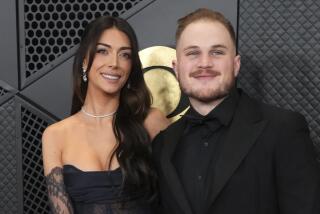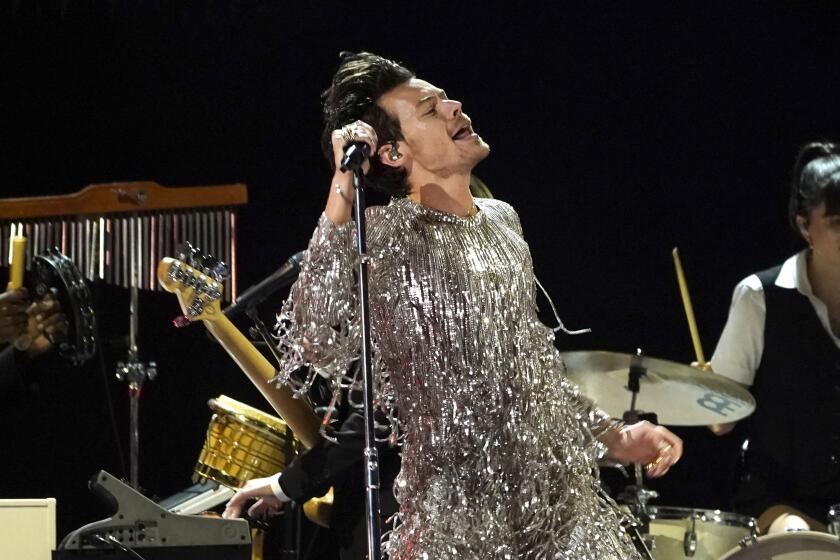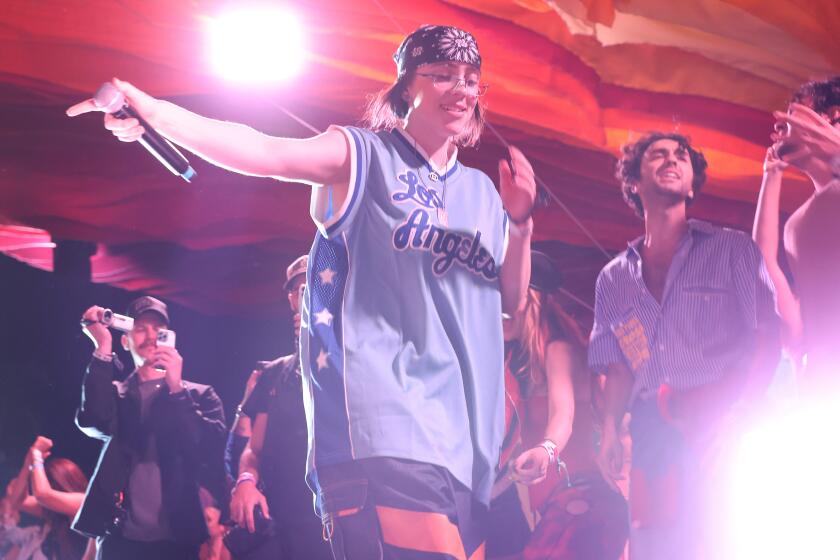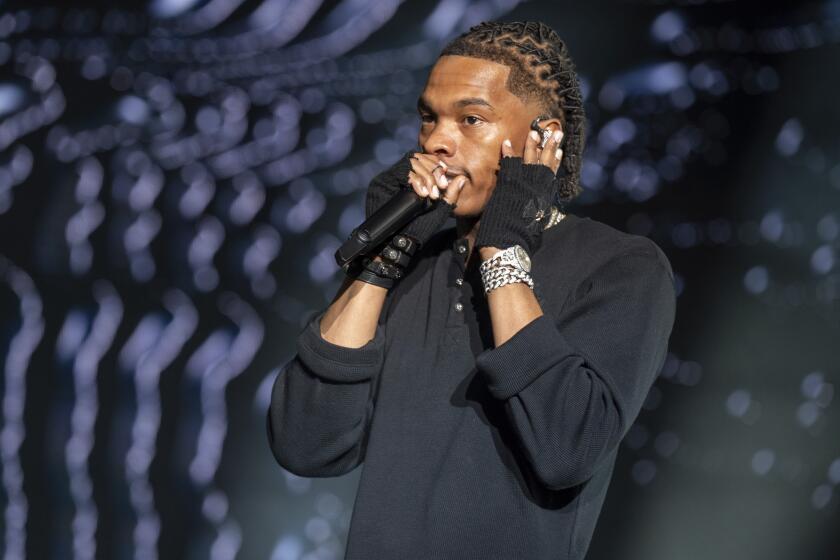More Greats Deserving of Ken Burns’ Focus
One of the most important long-range accomplishments of the Ken Burns “Jazz” documentary, which continues into next week, may well be the CD collections that have been released as audio companions. The official collection--”Ken Burns’ Jazz”--is a five-CD boxed set, and there is also a single CD, personally selected by Burns.
More expansively, there are 22 albums devoted to individual artists, 11 from Verve, 11 more from Columbia Legacy. Those albums--especially valuable since they gather tracks from entire careers, regardless of label affiliation--represent the work of the artists most prominently featured in “Jazz” the documentary.
And there is no denying that it is a distinguished list. The albums in the Verve 11 are devoted to Count Basie, Art Blakey, John Coltrane, Ella Fitzgerald, Dizzy Gillespie, Coleman Hawkins, Billie Holiday, Charlie Parker, Sonny Rollins, Sarah Vaughan and Lester Young. The Columbia Legacy artists are Louis Armstrong, Sidney Bechet, Dave Brubeck, Miles Davis, Duke Ellington, Benny Goodman, Herbie Hancock, Fletcher Henderson, Charles Mingus, Thelonious Monk and Ornette Coleman.
So far, so good. But why stop there? It doesn’t take a great deal of heavy thinking to come up with two more lineups of 11 artists, any one of whom might arguably have been included in the original groupings. So here’s my first, pre-’60s-oriented list of 11, freely available to Verve, Columbia Legacy or any other company that wants to step up to the plate (a few are represented by a track or two in the five-CD boxed set). Next week, given the relative absence of more contemporary artists in the Burns collection, I’ll add 11 more, weighted toward the sort of players who were largely shut out by his post-’60s cut. (And I’ll wager that most of the folks who read this column can come up with other, equally provocative groupings of their own.)
* Bix Beiderbecke. How would Beiderbecke have fared had he lived beyond the age of 28? Hard to say, but what he did produce was an approach to the trumpet (cornet, actually) that was a strikingly creative counter to Armstrong’s work of the ‘20s. “Singin’ the Blues” (Columbia) and “The Indispensable Bix Beiderbecke” provide a fairly thorough overview of his brief career.
* Jimmie Lunceford Orchestra. A marvelous band from the ‘30s and ‘40s whose hard-swinging, well-crafted music tended to be underrated because of the ensemble’s upfront showmanship. “Stomp It Off” (Universal) affords a good introduction.
* Roy Eldridge. Between Armstrong and Gillespie there was “Little Jazz” Eldridge. “Roy Eldridge 1935-40” (Jazz Classics) covers some early high points in his career, but there is much, much more, since he was active well into the ‘70s.
* Art Tatum. Listening to his recordings from the early ‘30s is mind-boggling, even today, and one could make a case for him as one of the great pianists of the 20th century, regardless of genre. The five-CD box includes his “Three Little Words,” but one can’t go wrong with any Tatum recordings. “Piano Starts Here” (Columbia) is exactly that--a good starting place.
* Woody Herman and His Orchestra. Herman started with a blues band, but his outfits of the ‘40s and ‘50s were among the first to deliver a powerful, accessible version of bebop. And numbers such as “Early Autumn” and “Four Brothers” have become jazz classics. “Keeper of the Flame” (Capitol) and “The Thundering Herds 1945-1947” (Columbia) cover some of the more exciting years.
* Stan Kenton. Like Herman, Kenton went from a swing phase to bebop and beyond. Always adventurous, sometimes pompous, his orchestras were never boring, and his personnel included first-rate soloists. While there are dozens of Kenton albums available, “The Best of Stan Kenton” (Blue Note) is a good cross-decade sampler, and “New Concepts” (Blue Note) features one of his most impressive lineups of players.
* Erroll Garner. Omitted from the “Jazz” documentary because, according to Burns, he was not an innovative force, Garner proves the contrary in almost every recording he made. He was, by any standard, a pianist with an utterly unique voice. “The Essence of Erroll Garner” (Columbia) includes one of numerous versions of his “Misty,” and “Concert By the Sea” (Columbia), despite audio problems, is a classic.
* Bud Powell. Can there be bebop without Bud? Probably not. The five-CD box includes his trio version of “Get Happy,” but listen to the complete extent of his piano artistry in the four-CD “Complete Blue Note and Roost Recordings” (Blue Note).
* Gerry Mulligan. Composer, baritone saxophonist and arranger, Mulligan probably surprised even himself when he became one of the most widely known jazz artists of the ‘50s and beyond. His appealing work with Chet Baker is detailed in “The Original Quartet With Chet Baker” (Blue Note), but there are dozens of other CDs encompassing sessions with Lee Konitz, Ben Webster, Paul Desmond and others.
* Gil Evans. Although he leaves a very small legacy of original works, Evans was the consummate jazz arranger, his efforts more accurately described as re-compositions. His collaborations with Miles Davis are classics, but don’t overlook his superb small band recordings from the late ‘50s and early ‘60s: “Gil Evans & Ten” (Fantasy), “Out of the Cool” (Universal) and, if you can find it, “New Bottle, Old Wine” (Blue Note).
* Carmen McRae. Never quite included at the level of the Holiday/Fitzgerald/Vaughan triumvirate, McRae at her best was a marvelously articulate vocalist. Coolly musical with a rich understanding of rhythm, her singing deserves more careful consideration. Check out her early career and some of her more commercial efforts in “I’ll Be Seeing You” (Universal) and follow it up with her marvelous “Carmen Sings Monk” (BMG/Novus).
More Burns: Amazon.com reports that the five-CD boxed set of music from Ken Burns’ “Jazz” documentary is a breakout success. The day after the first episode aired, the set was ranked No. 1, and 19 jazz titles were represented in the site’s Top 100 best-sellers--an amazing accomplishment. CDNow reports that sales of the Burns box increased by 400% in the documentary’s first week of airing, and that it is now No. 4 on CDNow’s top sellers. Sales of the 10-disc DVD package increased nearly 500%, and sales of other Burns-related jazz CDs doubled and in some cases tripled and quadrupled. It remains to be seen whether the sales bumps will continue and, perhaps more important, whether they will embrace the work of young performers.
Club News: No word yet on where or when Rocco Somazzi will open his second installment of Rocco’s jazz club. But musicians and fans who grew accustomed to stopping by the original venue at the top of Beverly Glen are growing restless. Stay tuned. . . . Jazz, in the meantime, is turning up in some other locations. Charlie O’s in Van Nuys has begun a regular schedule of performances featuring the Earl Palmer Trio and the John Heard Trio, with a variety of guest artists (tonight, Bill Perkins with the Heard group). 13725 Victory Blvd. (at Woodman Avenue), (818) 994-3058. . . . And the Sunset Room, one of Hollywood’s latest happening rooms, is starting to program jazz on Wednesday nights, thanks to entertainment director Lenetta Kidd, who once maintained a full schedule of jazz at the Moonlight Tango in Sherman Oaks. 1430 N. Cahuenga Blvd., (323) 463-0004.
More to Read
The biggest entertainment stories
Get our big stories about Hollywood, film, television, music, arts, culture and more right in your inbox as soon as they publish.
You may occasionally receive promotional content from the Los Angeles Times.






